Circuit Breaker Rate-of-Rise Recovery Voltage in Ultra-High Voltage Lines with Hybrid Reactive Power Compensation
Abstract
:1. Introduction
2. The HRPC Equivalent Model and Simulation System
3. Circuit Breaker RRRV at Out-of-Phase Faults
3.1. Simulation Analysis for Out-of-Phase Faults
3.2. Theoretical Computation for Out-of-Phase Faults
4. Circuit Breaker RRRV at Short-Line Fault
4.1. Simulation Analysis for Short-Line Faults
4.2. Theoretical Computation for Short-Line Faults
5. Conclusions
Acknowledgments
Author Contributions
Conflicts of Interest
References
- Liu, Z.Y. Innovation of UHV AC transmission technology in China. Power Syst. Technol. 2013, 37, T1–T8. [Google Scholar] [CrossRef]
- Huang, D.C.; Shu, Y.B.; Ruan, J.J.; Hu, Y. Ultra high voltage transmission in China: Developments, current status and future prospects. Proc. IEEE 2009, 97, 555–583. [Google Scholar] [CrossRef]
- Li, Q.M.; Liu, H.S.; Lou, J.; Zou, L. Impact research of inductive FCL on the rate of rise of recovery voltage with circuit breakers. IEEE Trans. Power Deliv. 2008, 23, 1978–1985. [Google Scholar] [CrossRef]
- Oshita, Y.; Hirasawa, K.; Kurosawa, Y. Investigation of an SF6 ultra high voltage circuit breaker using an opening resistor and auxiliary interrupter. IEEE Trans. Power Deliv. 1992, 7, 346–352. [Google Scholar] [CrossRef]
- Das, J.C. Reducing interrupting duties of high-voltage circuit breakers by increasing contact parting time. IEEE Trans. Ind. Appl. 2008, 44, 1027–1033. [Google Scholar] [CrossRef]
- Rai, D.; Faried, S.O.; Ramakrishna, G.; Edris, A.A. An SSSC-based hybrid series compensation scheme capable of damping subsynchronous resonance. IEEE Trans. Power Deliv. 2011, 27, 531–540. [Google Scholar] [CrossRef]
- El-Marsafawy, M. Application of series-capacitor and shunt-reactor compensation to an existing practical AC transmission line. IEE Proc. Gener. Trans. Distrib. 1991, 138, 330–336. [Google Scholar] [CrossRef]
- Elenius, S.; Uhlen, K.; Lakervi, E. Effects of controlled shunt and series compensation on damping in the nordel system. IEEE Trans. Power Syst. 2005, 20, 1946–1957. [Google Scholar] [CrossRef]
- Cai, H.S.; Hu, D.H.; Tu, C.Q.; Li, M.; Zhu, L.; Huang, B.J.; Yao, S.L. Study on the shunt compensation and overvoltage in Zhengnan 500 kV System. High Volt. Eng. 2000, 26, 58–60. [Google Scholar]
- Xu, L.; Sheng, Z.; Fu, G.; Gao, G.; Benfatto, I.; Mankani, A.D.; Tao, J. The reactive power compensation and harmonic filtering and the over-voltage analysis of the ITER power supply system. In Proceedings of the 2010 Twenty-Fifth Annual IEEE, Applied Power Electronics Conference and Exposition (APEC), Palm Springs, CA, USA, 21–25 February 2010; pp. 1622–1626. [Google Scholar] [CrossRef]
- Indulkar, C.S.; Viswanathan, B.; Venkata, S.S. Maximum power transfer limited by voltage stability in series and shunt compensated schemes for AC transmission systems. IEEE Trans. Power Deliv. 1989, 4, 1246–1252. [Google Scholar] [CrossRef]
- Na, H.; Li, Y.M.; Wei, Z.Y.; Li, W.Z.; Yao, L.; Yao, S.L. Analysis and study on out-of-phase fault of circuit breaker’s break-off with opening resistance. Electrotech. Electr. 2011, 12, 13–18. [Google Scholar]
- International Electrotechnical Commission. High-Voltage Switchgear and Controlgear—Part 100: High-Voltage Alternating-Current Circuit-Breakers; IEC62271; International Electrotechnical Commission: London, UK, 2001. [Google Scholar]
- Zheng, B.; Xiang, Z.T.; Ban, L.G.; Gu, N.H.; Wang, X.T.; Han, B. Analysis on circuit breaker transient recovery voltage UHV AC transmission lines fixed with series capacitors. High Volt. Eng. 2013, 39, 605–611. [Google Scholar] [CrossRef]
- Zhang, Y.Y.; Ban, L.G.; Xiang, Z.T.; Lin, J.M.; Zheng, B.; Zhang, Y.P.; Han, B.; Han, Y.N. Research on working condition of key components for fixed series compensation in 1000 kV UHV AC power transmission project. Power Syst. Technol. 2013, 37, 2218–2224. [Google Scholar]
- Liu, H.S.; Lv, T.T.; Han, M.M.; Li, B.; Wang, G.; Li, Q.Q. Overvoltage amplitude and frequency characteristics of energizing off-load UHV transmission line with hybrid reactive compensation. Power Syst. Technol. 2015, 39, 1970–1976. [Google Scholar] [CrossRef]
- Ma, Q.Y.; Zheng, B.; Ban, L.G.; Xiang, Z.T. Secondary arc current analysis of an untransposed EHV/UHV transmission line with controllable unbalanced shunt reactor. IEEE Trans. Power Deliv. 2014, 30, 127–135. [Google Scholar] [CrossRef]
- Zhou, P.H.; He, H.W.; Dai, M. Application of controllable reactors to 1000 kV AC compact transmission line. High Volt. Eng. 2011, 37, 127–135. [Google Scholar] [CrossRef]
- Tian, M.M.; Yin, J.N.; Liu, Y.B. Magnetic integration technology in controllable reactor of transformer type constituted by various magnetic materials. IEEE Trans. Appl. Supercond. 2014, 24, 1–5. [Google Scholar] [CrossRef]
- Rifaat, R.; Lally, T.S.; Hong, J. Circuit Breaker Transient Recovery Voltage Requirements for Medium-Voltage Systems with NRG. IEEE Tran. Ind. Appl. 2014, 50, 309–316. [Google Scholar] [CrossRef]
- Wei, X.; Zhou, Z.C.; Xie, T.X.; Tao, F.; Liu, Y.; He, J. Analysis and protection against overvoltages caused by vacuum circuit breakers switching on shunt capacitors. High Volt. Eng. 2014, 40, 3193–3198. [Google Scholar] [CrossRef]
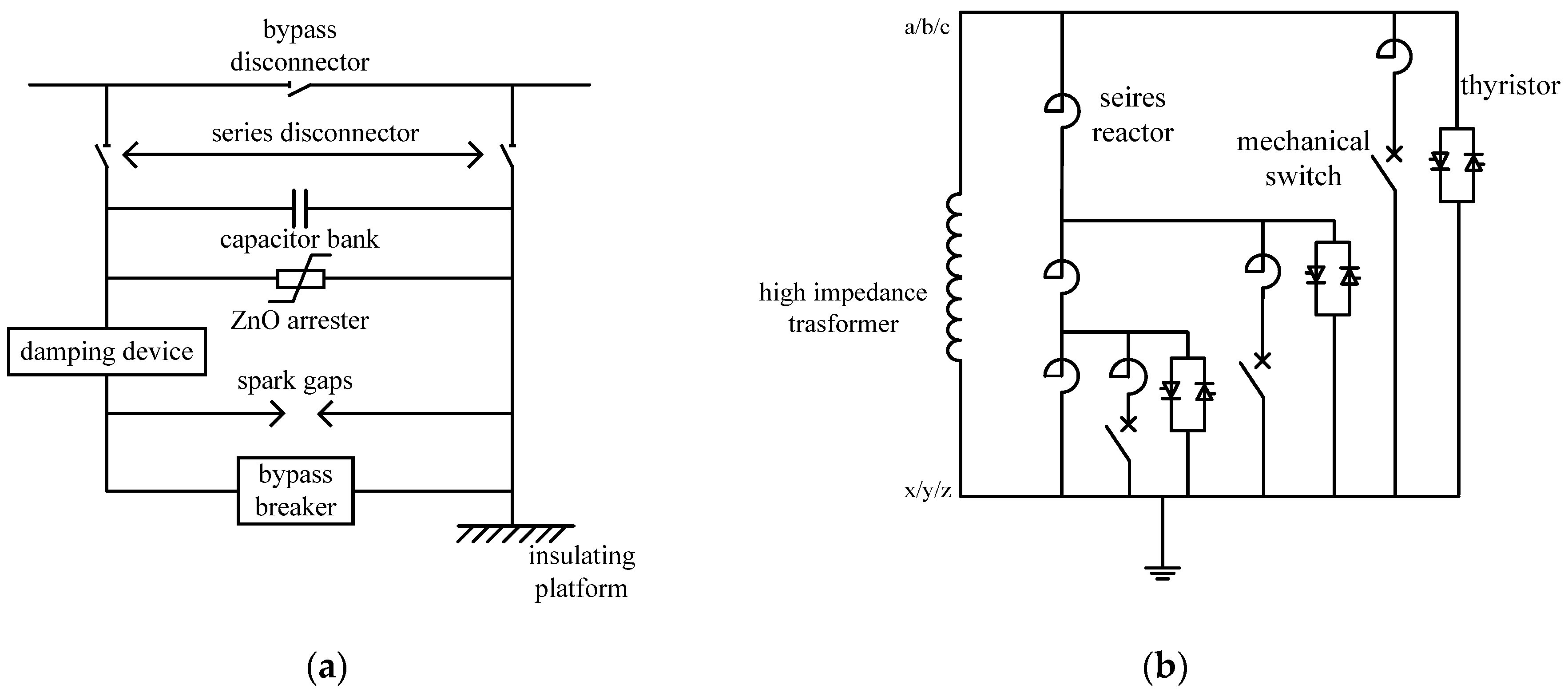

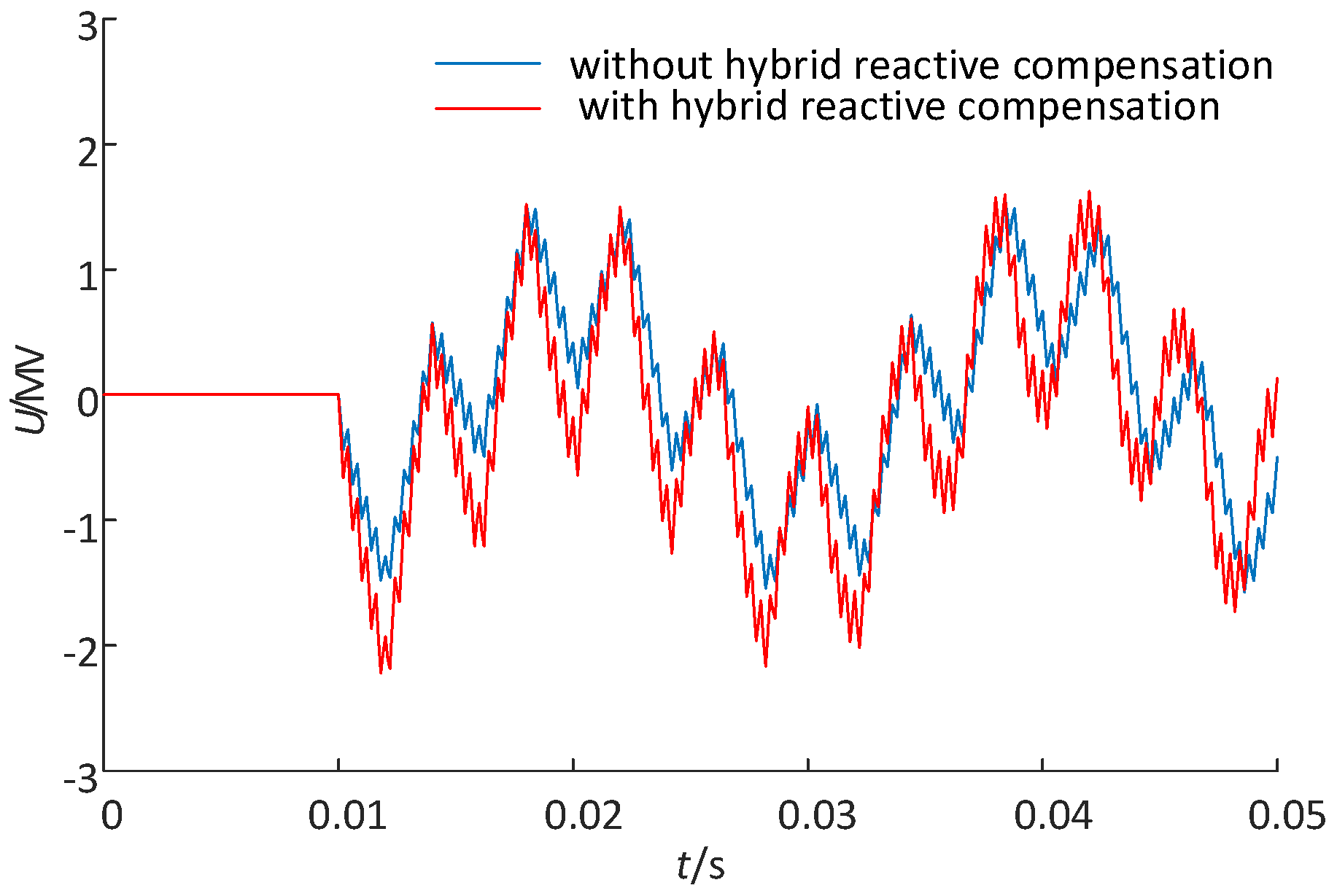
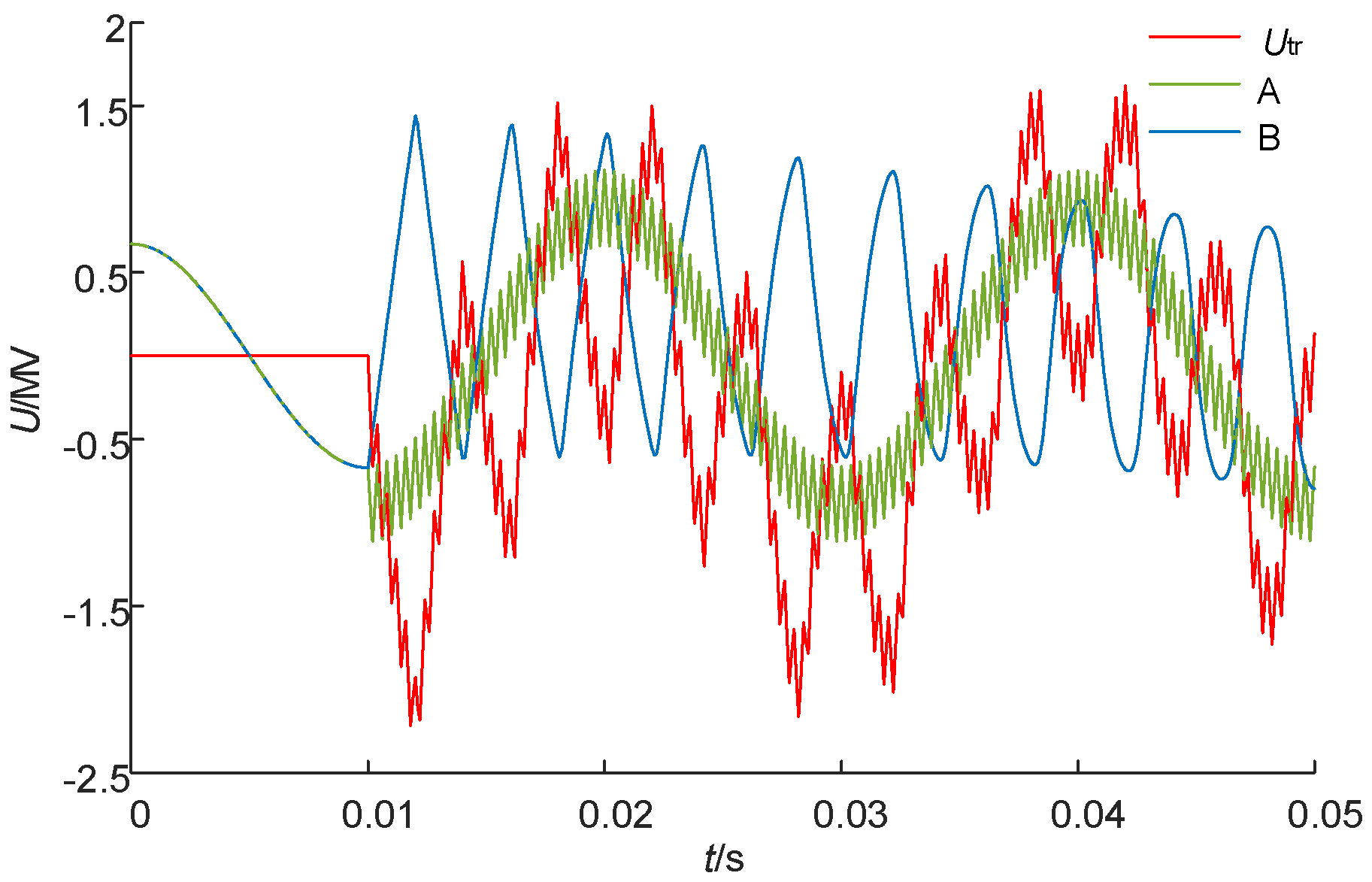
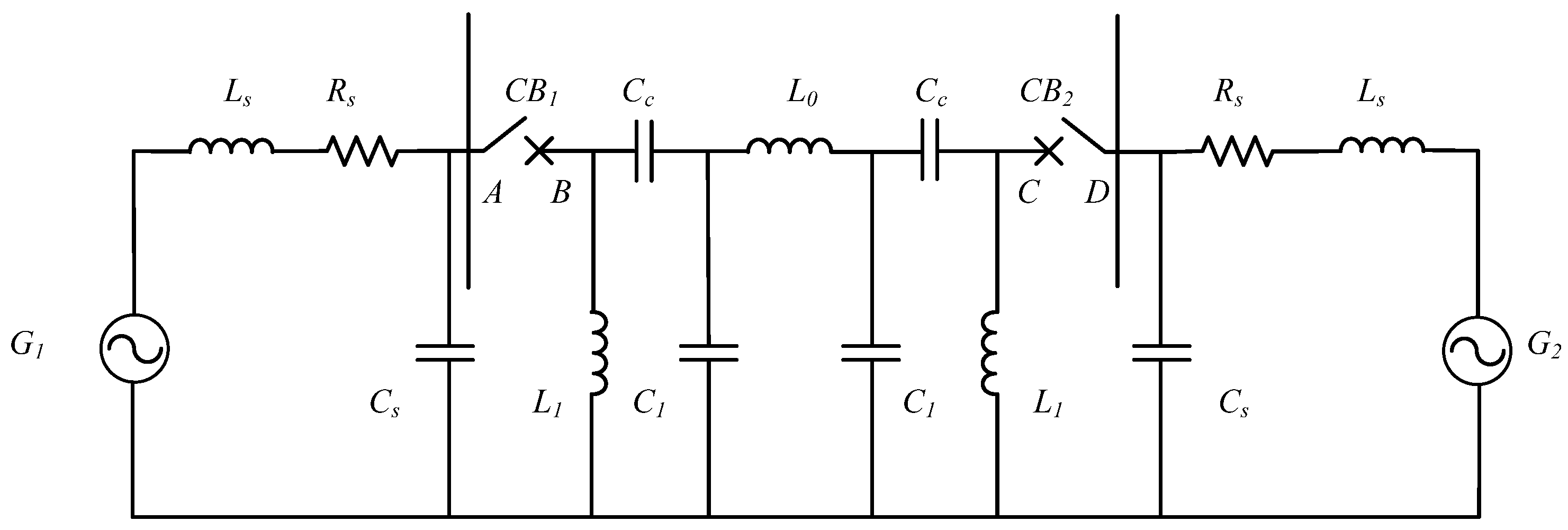

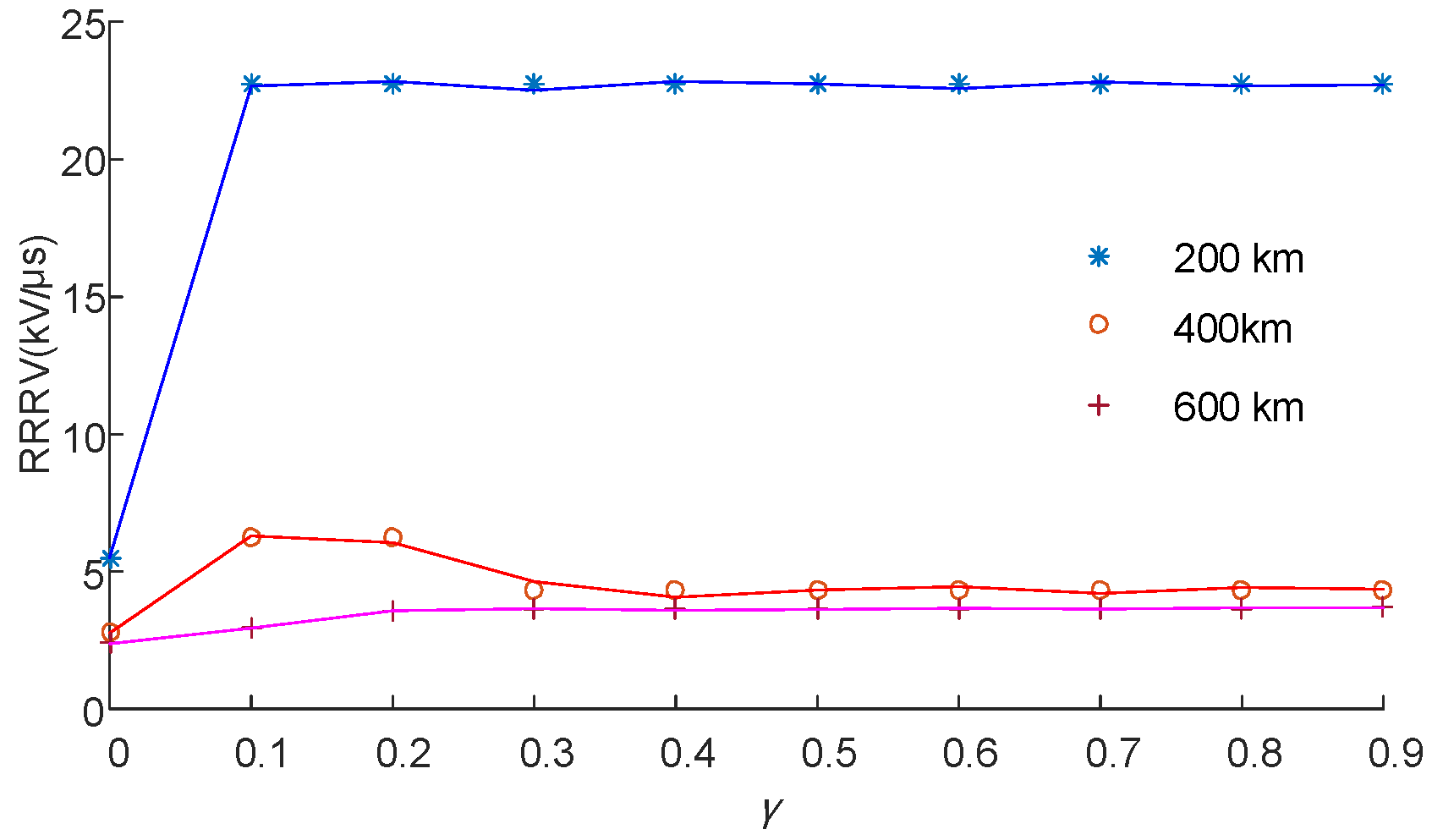
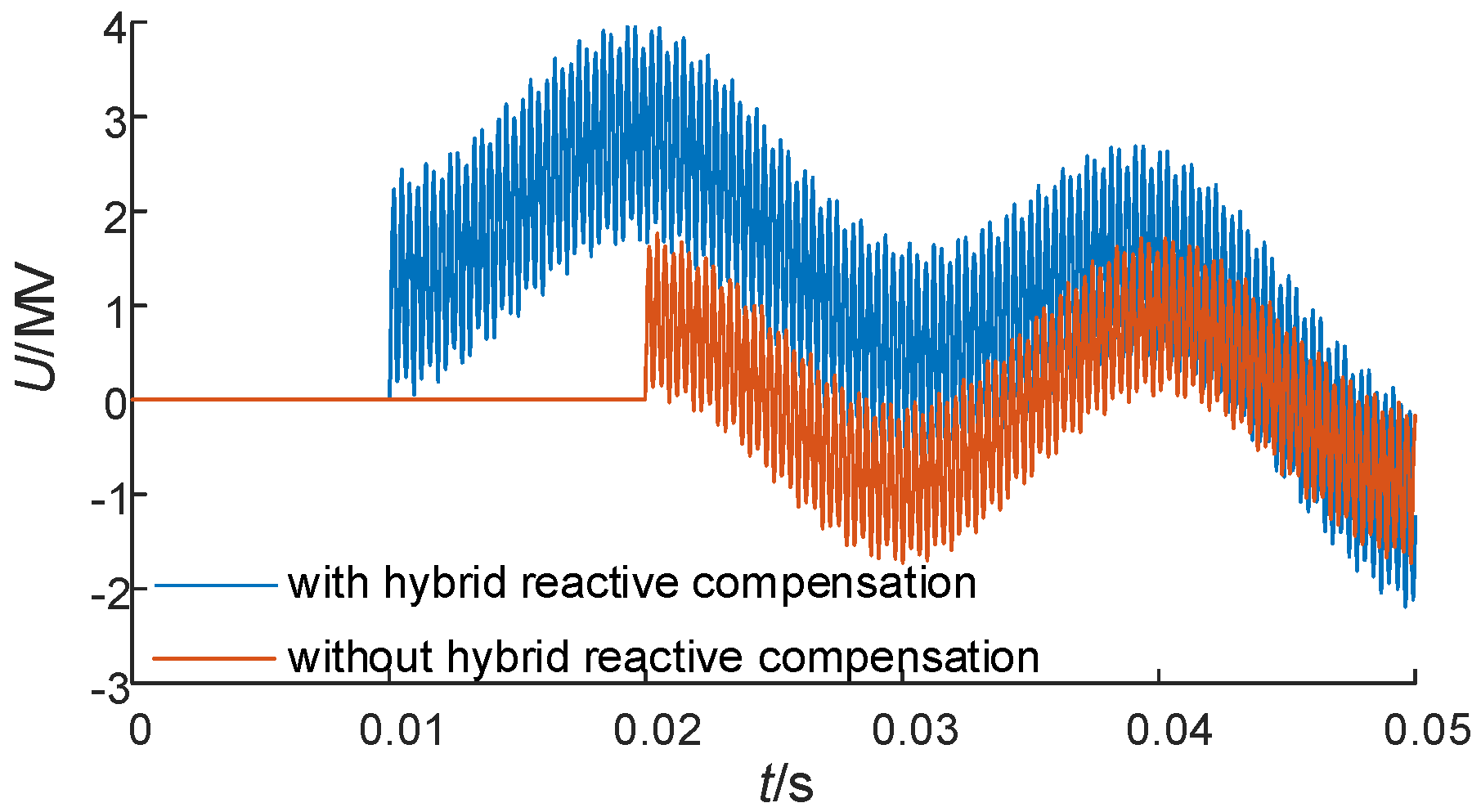
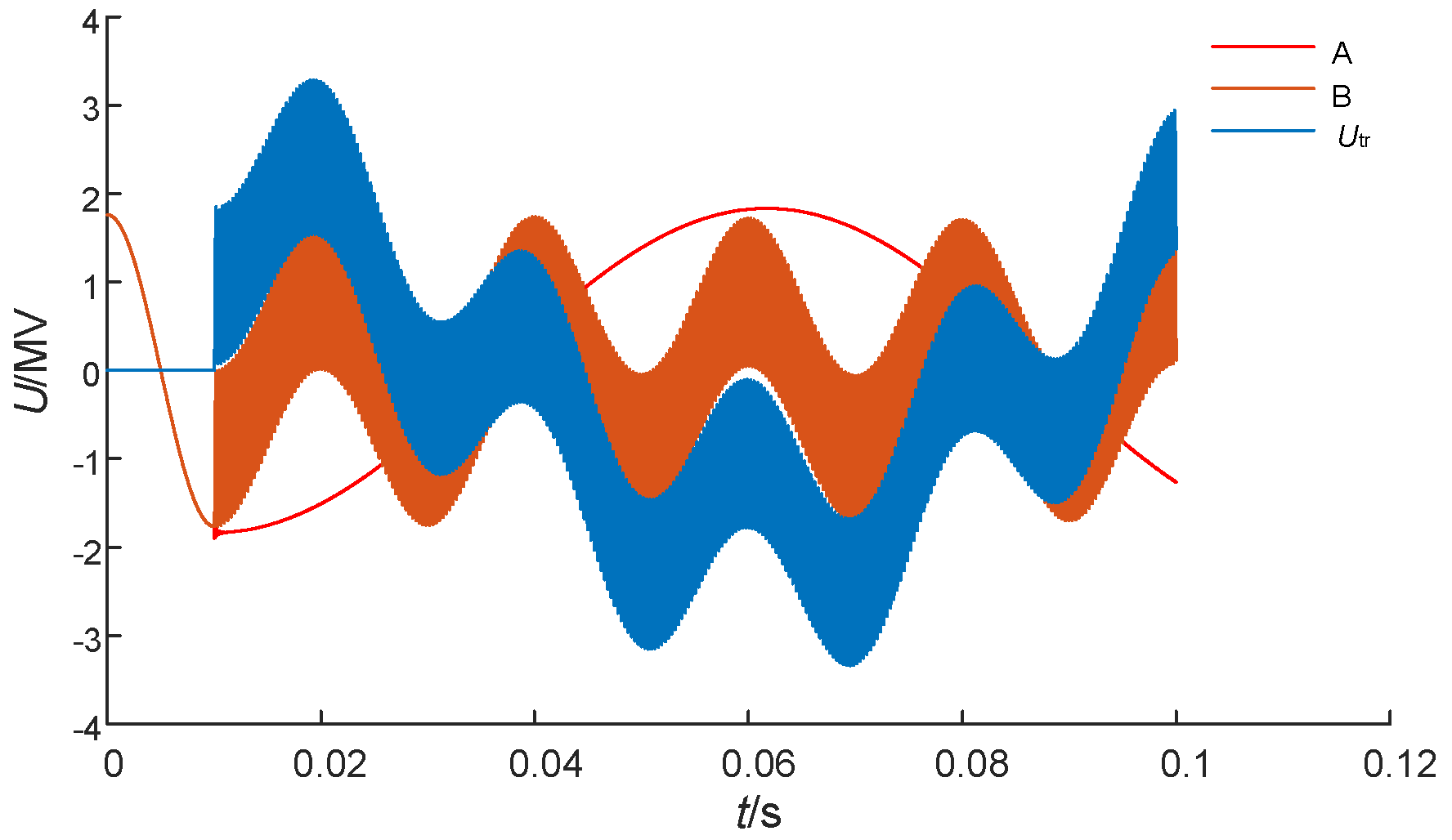
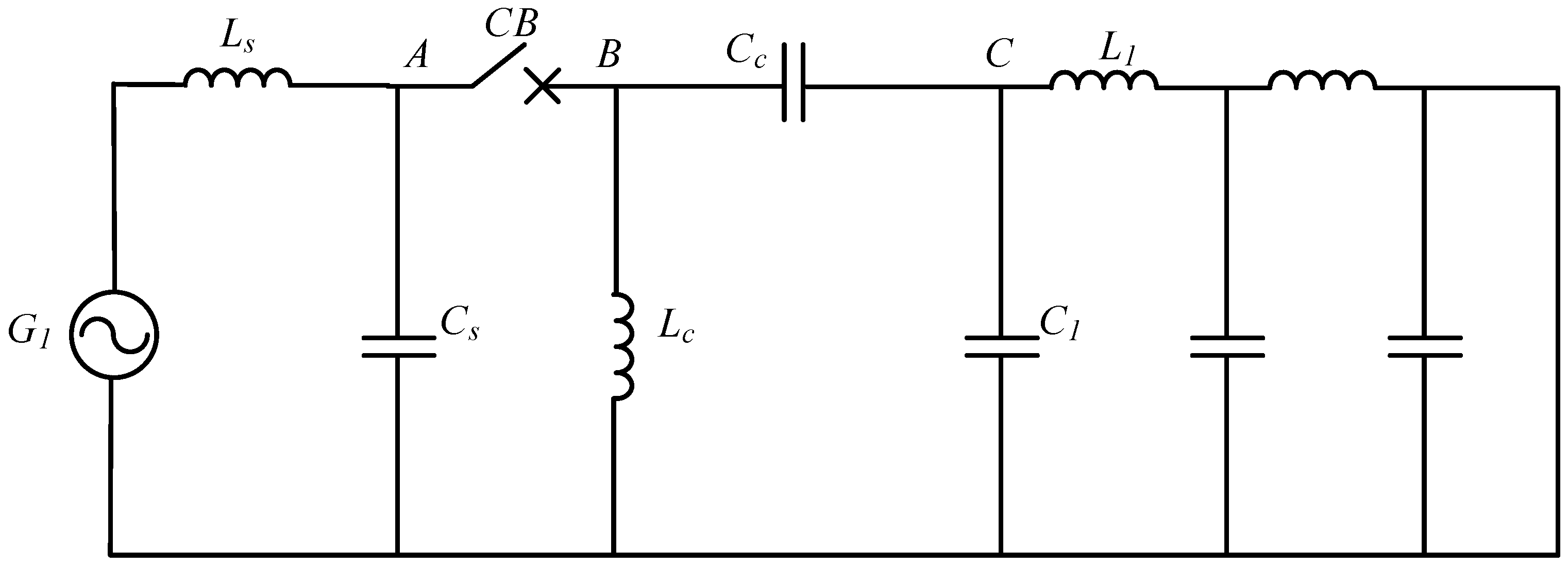
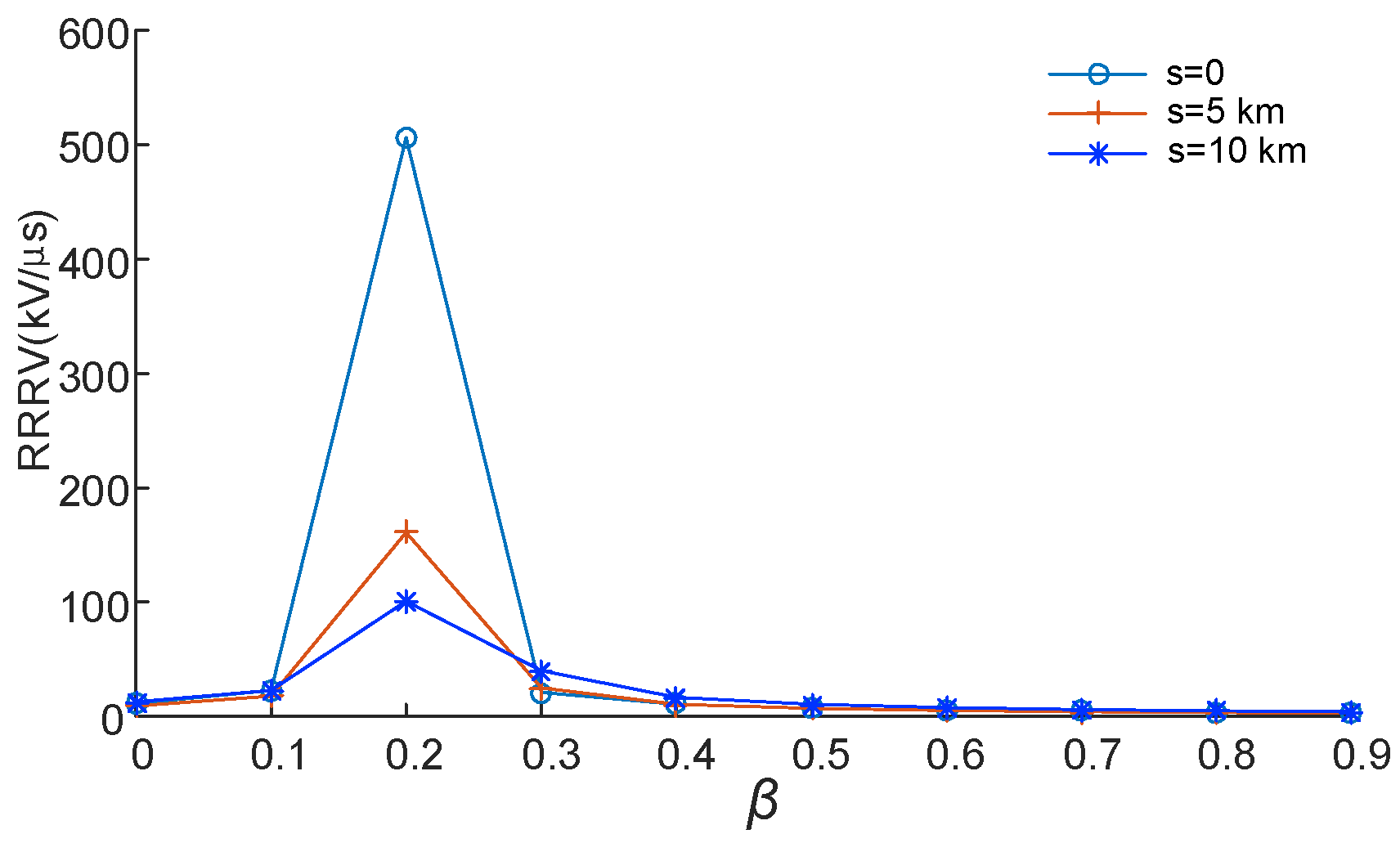
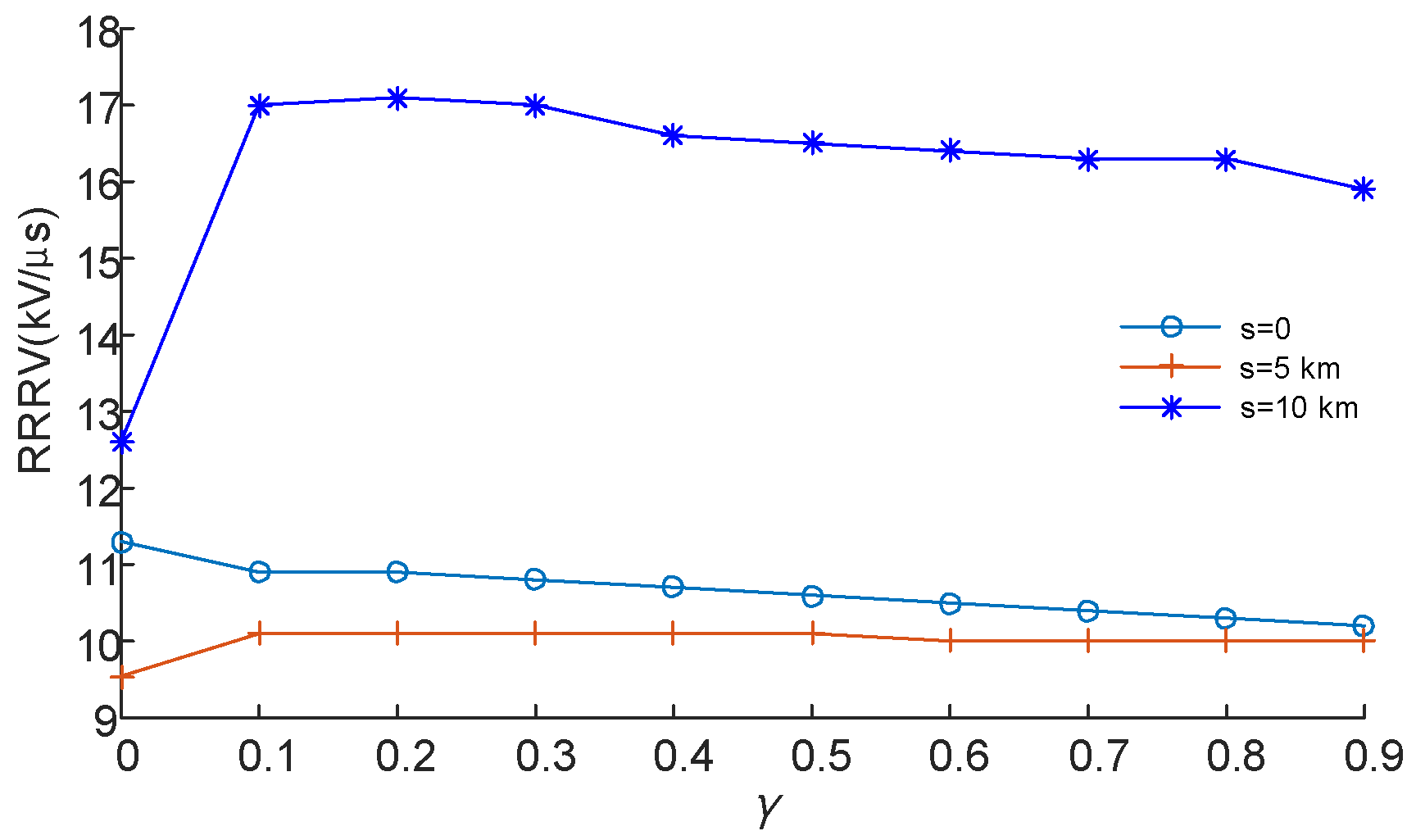
| Sequence | R/(Ω·km−1) | L/(mH·km−1) | C/(μF·km−1) |
|---|---|---|---|
| Positive Sequence | 0.00783 | 0.83408 | 0.01379 |
| Zero Sequence | 0.19637 | 2.67366 | 0.00846 |
© 2018 by the authors. Licensee MDPI, Basel, Switzerland. This article is an open access article distributed under the terms and conditions of the Creative Commons Attribution (CC BY) license (http://creativecommons.org/licenses/by/4.0/).
Share and Cite
Liu, H.; Wang, Z.; Yang, J.; Li, B.; Ren, A. Circuit Breaker Rate-of-Rise Recovery Voltage in Ultra-High Voltage Lines with Hybrid Reactive Power Compensation. Energies 2018, 11, 100. https://doi.org/10.3390/en11010100
Liu H, Wang Z, Yang J, Li B, Ren A. Circuit Breaker Rate-of-Rise Recovery Voltage in Ultra-High Voltage Lines with Hybrid Reactive Power Compensation. Energies. 2018; 11(1):100. https://doi.org/10.3390/en11010100
Chicago/Turabian StyleLiu, Hongshun, Zhen Wang, Jingjing Yang, Bin Li, and Ang Ren. 2018. "Circuit Breaker Rate-of-Rise Recovery Voltage in Ultra-High Voltage Lines with Hybrid Reactive Power Compensation" Energies 11, no. 1: 100. https://doi.org/10.3390/en11010100





